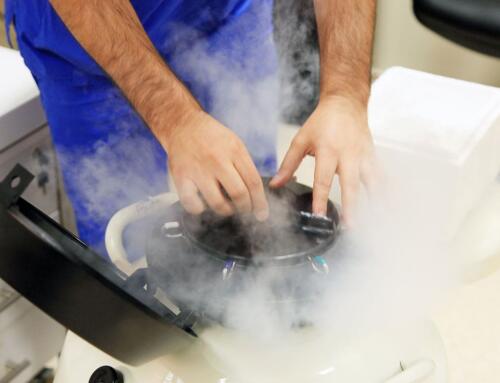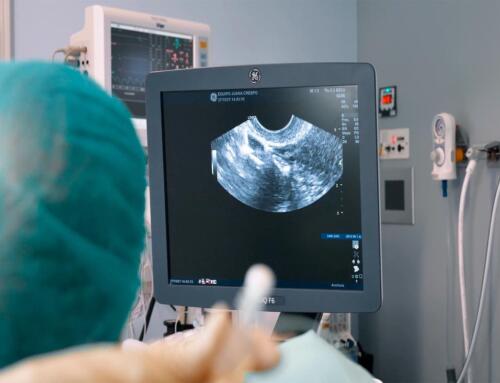Preimplantation Genetic Testing (PGT) is used to detect possible genetic and/or chromosomal disorders in embryos obtained during an in vitro fertilization cycle.
In addition to avoiding the risk of transmitting hereditary genetic diseases from parents to children, this technique allows for the selection of healthy embryos, of higher quality and with more potential for implantation, increasing success in assisted reproduction treatments.
What is the procedure for preimplantation genetic diagnosis?
PGD or PGT is a complex process that must always be performed by experts in embryology and genetics, using advanced techniques such as embryonic cell biopsy or molecular genetic analysis.
Its phases are:
- IVF. It is the procedure prior to Preimplantation Genetic Diagnosis. After ovarian stimulation of the woman, several mature eggs are obtained (through follicular puncture) and fertilized (with sperm from the male partner or an anonymous donor) using ICSI or intracytoplasmic sperm injection.
- Embryonic development. Embryos obtained with IVF are observed in their early hours of development to ensure they have the minimum quality necessary for biopsy and to guarantee their survival.
- Cell biopsy. It consists of extracting one or more cells from the embryo (blastomeres). Biopsy can be performed on day 3 of embryo development or once it has reached the blastocyst stage, 5 days after IVF.
- Genetic analysis. The sample obtained from the biopsy is placed in a tube. Specialists conduct a study of its chromosomes and genes to identify possible alterations.
- Embryo transfer. After obtaining the results of the genetic analysis, genetically healthy embryos are selected for transfer to the mother’s uterus or cryopreserved for future pregnancy attempts.
What is the difference between performing the biopsy on day 3 or day 5 of embryonic culture?
Embryonic cell biopsy is possibly the most delicate part of the entire preimplantation genetic testing (PGT) procedure.
It must always be performed by a highly specialized and experienced professional, as it is essential not to compromise the embryo’s viability.
When the biopsy is performed on the third day of its development, embryos of good quality have 8 cells, and only one of them is extracted by making a hole in the zona pellucida with short laser pulses or chemical agents.
The blastomere is then extracted through this hole by absorption.
If the biopsy is performed on the fifth day of embryo development, it has already become a blastocyst.
The blastocyst is larger, composed of many cells, and has three perfectly differentiated parts (inner cell mass or ICM, blastocoel, and trophectoderm).
When performing the biopsy with a blastocyst, short laser pulses are used to create the hole through which several embryonic cells are extracted using a micropipette through aspiration.
Performing the biopsy on the fifth day of embryonic development is simpler because the cells of the ICM and trophectoderm have the same genetic material, and extraction is safer.
However, at this more advanced stage, it is often necessary to vitrify the embryos after biopsy.
The reason is that the results of the genetic analysis may take several days, and it is not feasible to culture the embryos in the laboratory for such a long time.
Preimplantation Genetic Screening
Preimplantation genetic screening (PGS), commonly referred to as PGS, is a type of Preimplantation Genetic Testing (PGT) that examines alterations in the number or structure of the embryo’s chromosomes (aneuploidies). These alterations can result in recurrent miscarriages or the birth of unhealthy children.
The most prevalent test utilized is the Comparative Genomic Hybridization array, which conducts a Comprehensive Chromosomal Screening assessing the 23 pairs of chromosomes of the embryo.
To conduct this test, both a control DNA and a DNA sample extracted from the embryonic cell are utilized.
Preimplantation Genetic Diagnosis
Preimplantation genetic diagnosis (PGD) enables the identification of monogenic diseases, which are illnesses caused by mutations in a single gene.
Once the mutation is identified, along with the determination of the type of inheritance (dominant, recessive, or sex-linked), various techniques are employed, with Polymerase Chain Reaction (PCR) and massive sequencing being the most common for diagnosis.
Advantages of PGD through Massive Sequencing
Massive sequencing represents the most advanced method in the preimplantation genetic diagnosis process.
It permits the examination of the 23 pairs of chromosomes and over 500 genes associated with hereditary diseases in a single test. This includes the investigation of aneuploidies and monogenic diseases, both independently and simultaneously.
Additionally, it offers the advantage of rapid results acquisition, eliminating the need to freeze embryos while awaiting test confirmation.
Equipo Juana Crespo: specialists in Advanced Preimplantation Genetic Diagnosis
When do we recommend undergoing Preimplantation Genetic Testing?
We recommend Preimplantation Genetic Testing in the following cases:
- Parents (one or both) are carriers, symptomatic or asymptomatic, of a genetic disease or chromosomal anomaly.
- Women who are carriers of an X-linked genetic disease.
- Couples who have experienced recurrent miscarriages or implantation failures, in both natural pregnancies and IVF.
- Presence of family history.
- Advanced maternal age.
- One of the parents is ill.
When do we perform the biopsy?
At Equipo Juana Crespo, we perform Preimplantation Genetic Testing on blastocyst-stage embryos, 5-6 days after fertilization.
At this stage, they have an inner cell mass that will develop into the fetus and an outer layer that will become the placenta (trophectoderm).
The biopsy is performed on the latter, to avoid affecting fetal development.
Before conducting this test, it is important to have a good number of embryos to discard any anomalies and transfer only those of quality and diagnosed as genetically “normal.”
The biopsied samples of all embryos are studied in our own genetics laboratory.
This, combined with our experience, has allowed us to achieve one of the highest success rates in Preimplantation Genetic Diagnosis.
What types of preimplantation diagnostic tests do we perform in our clinic?
Currently, we perform two types of tests for Preimplantation Genetic Testing:
- PGT-A or Preimplantation Genetic Testing for Aneuploidy: To determine if the number of chromosomes in an embryo is correct. It is performed in cases of advanced maternal age, couples with altered karyotypes, and patients with recurrent miscarriages or previous interruptions due to chromosomal abnormalities.
- PGT-M or Preimplantation Genetic Testing for Monogenic Diseases: To detect monogenic genetic diseases in the embryo before implantation. It is performed on patients with hereditary diseases or with a matching compatibility test for the same disease between the parents. Prior to this, a series of genetic tests must be conducted on the couple and their relatives.
Do you have questions about the preimplantation genetic diagnosis procedure? Feel free to inquire with us for information, without any obligation.
















